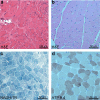This is a preprint.
Genotype-phenotype correlation in recessive DNAJB4 myopathy
- PMID: 39483874
- PMCID: PMC11527209
- DOI: 10.21203/rs.3.rs-4915388/v1
Genotype-phenotype correlation in recessive DNAJB4 myopathy
Update in
-
Genotype‒phenotype correlation in recessive DNAJB4 myopathy.Acta Neuropathol Commun. 2024 Oct 28;12(1):171. doi: 10.1186/s40478-024-01878-w. Acta Neuropathol Commun. 2024. PMID: 39468638 Free PMC article.
Abstract
Protein aggregate myopathies can result from pathogenic variants in genes encoding protein chaperones. DNAJB4 is a cochaperone belonging to the heat shock protein-40 (HSP40) family and plays a vital role in cellular proteostasis. Recessive loss-of-function variants in DNAJB4 cause myopathy with early respiratory failure and spinal rigidity, presenting from infancy to adulthood. This study investigated the broader clinical and genetic spectrum of DNAJB4 myopathy. In this study, we performed whole-exome sequencing on seven patients with early respiratory failure of unknown genetic etiology. We identified five distinct pathogenic variants in DNAJB4 in five unrelated families of diverse ethnic backgrounds: three loss-of-function variants (c.547C > T, p.R183*; c.775C > T, p.R259*; an exon 2 deletion) and two missense variants (c.105G > C, p.K35N; c.181A > G, p.R61G). All patients were homozygous. All affected individuals exhibited early respiratory failure, and patients from three families had rigid spine syndrome with axial weakness in proportion to appendicular weakness. Additional symptoms included dysphagia, ankle contractures, scoliosis, neck stiffness, and cardiac dysfunction. Notably, J-domain missense variants were associated with a more severe phenotype, including an earlier age of onset and a higher mortality rate, suggesting a strong genotype-phenotype correlation. Consistent with a loss of function, the nonsense variants presented decreased stability. In contrast, the missense variants exhibited normal or increased stability but behaved as loss-of-function variants in yeast complementation and TDP-43 disaggregation assays. Our findings suggest that DNAJB4 is an emerging cause of myopathy with rigid spine syndrome of variable age of onset and severity. This diagnosis should be considered in individuals presenting with suggestive symptoms, particularly if they exhibit neck stiffness during infancy or experience respiratory failure in adults without significant limb muscle weakness. Missense variants in the J-domain may predict a more severe phenotype.
Keywords: Chaperonopathy; DNAJB4; Heat shock proteins; Protein aggregate myopathy; Respiratory failure; Rigid spine syndrome.
Conflict of interest statement
Competing Interests The authors declare that they have no competing interests.
Figures




References
-
- Weihl CC, Udd B, Hanna M, group on behalf of the E workshop study, Ben-Zvi A, Blaettler T et al. (2018) 234th ENMC International Workshop: Chaperone dysfunction in muscle disease Naarden, The Netherlands, 8–10 December 2017. Neuromuscul Disord. ;28:1022–30. 10.1016/j.nmd.2018.09.004 - DOI - PMC - PubMed
Publication types
Grants and funding
LinkOut - more resources
Full Text Sources

